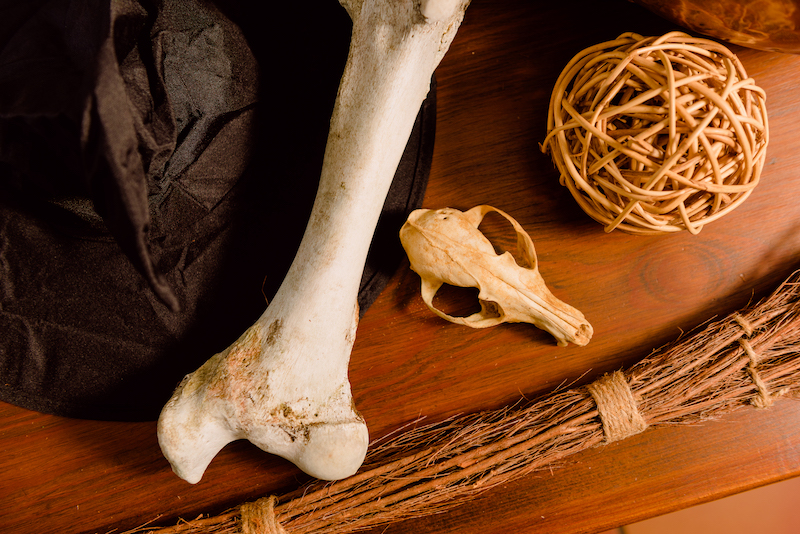Today’s Welsh word is asgwrn, which means bone. It’s a masculine noun, and the plural form is esgyrn.
asgwrn
bone
The word evolved through the Middle Welsh ascurn, originating from the proto-Celtic *astkorn, which is also the ancestor of the Cornish and Breton askorn. *Astkorn was made up of the elements *ast (bone) and *kornu (horn), coming all the way from proto-Indo-European.
Kornu in particular has had an imprint on many European languages, being the source of the Latin root word cornu (as in unicorn or cornucopia), and the English word horn. And you can see the descendant of *ast in the medical prefix os- in Romantic and Germanic languages, for example in the English words osteopath or ossuary.
Because asgwrn starts with a vowel, it doesn’t ever mutate. However, after eu (their), ein (our), or ei (his/her) when it is used to mean her, it undergoes what is called h-prosthesis and becomes hasgwrn. So, for example, her bone is ei hasgwrn and our bones is ein hesgyrn.
There are plenty of complex medical terms that have evolved from asgwrn and esgyrn, such as echasgwrn (exostosis) or clefyd esgyrn brau (osteoporosis). However, unless you’re a doctor, I assume you won’t need to learn those! Some potentially more useful related terms are esgyrnog (bony) and esgyrnu/asgyrnu (to ossify).
Rhaid i blant yfed llaeth i dyfu esgyrn cryf.
Children have to drink milk to grow strong bones.
Esgyrn are a type of organ (organ) which support the structure and movement of the body. They are strengthened by consuming plenty of calsiwm (calcium). Bones are largely made up of meinwe esgyrnog (osseous tissue), but they also include mêr esgyrn (bone marrow), nerfau (nerves), and cartilag (cartilage).
Most of the bones in the human sgerbwd (skeleton) are translated very simply, with the word asgwrn followed by the word for the part of the body where that particular bone is located. For example, asgwrn coler (collarbone), asgwrn cefn (spine), asgwrn gên (jaw), asgwrn coel (shoulderblade) or asgwrn dwyfron (breastbone).
But like in English, some esgyrn in the corff (body) have their own term, such as penglog (skull) and asen (rib).
Some verbs you might need to use with asgwrn include:
- torri/ysigo asgwrn (break/fracture a bone)
- cracio asgwrn (crack a bone)
- iachau/trwsio asgwrn (heal/mend a bone)
- tyfu asgwrn (grow a bone)
- gosod asgwrn yn ei le (set a bone)
- asgwrn i grafu (a bone to pick)
Of course, humans aren’t the only anifeiliad (animals) with bones; all fertebriaid (vertebrates) have them. There is a special term in Welsh for the small, delicate bones of a fish, which is blew pysgodyn – this literally means fish hair or fish fur. It’s notoriously difficult to bone a fish, and the Welsh term for bone as a verb is tynnu esgyrn or diesgyrnu.
A similar phrase, yr asgwrn tynnu (literally: the pulling bone), refers to the wishbone in poultry meat, though you can also call this asgwrn y gwenydd.
Pwy sy eisiau’r asgwrn tynnu?
Who wants the wishbone?
Several English idioms referring to bones are the same, or very similar, in Welsh. You can describe someone as dim ond croen ar yr asgwrn (nothing but skin on the bone), express that you feel something ym mêr fy esgyrn (in the marrow of my bones), discuss asgwrn y gynnen (a bone of contention) or gweithio hyd at yr asgwrn (work yourself to the bone).
You can also say magu asgwrn cefn (to raise a spine), which is the equivalent of to grow a backbone, and if someone hasn’t done the former, they may be acting yn ddi-asgwrn-cefn (spinelessly).
Another expression uses the unique Welsh word migwrn, which usually refers to the bone of the ankle or knuckle, but is often used to denote various small bones or wrists. If you want to say every bone in my body was aching, you can say roedd pob migwrn ac asgwrn yn brifo gennyf.
There are a few phrases that are a bit more specific to Welsh though – like the exclamation Esgyrn Dafydd! (David’s bones!) And if you want to describe someone as talking very loudly, at the top of their voice, you can say they’re speaking nerth esgyrn ei ben (with the strength of the bones of their head).


